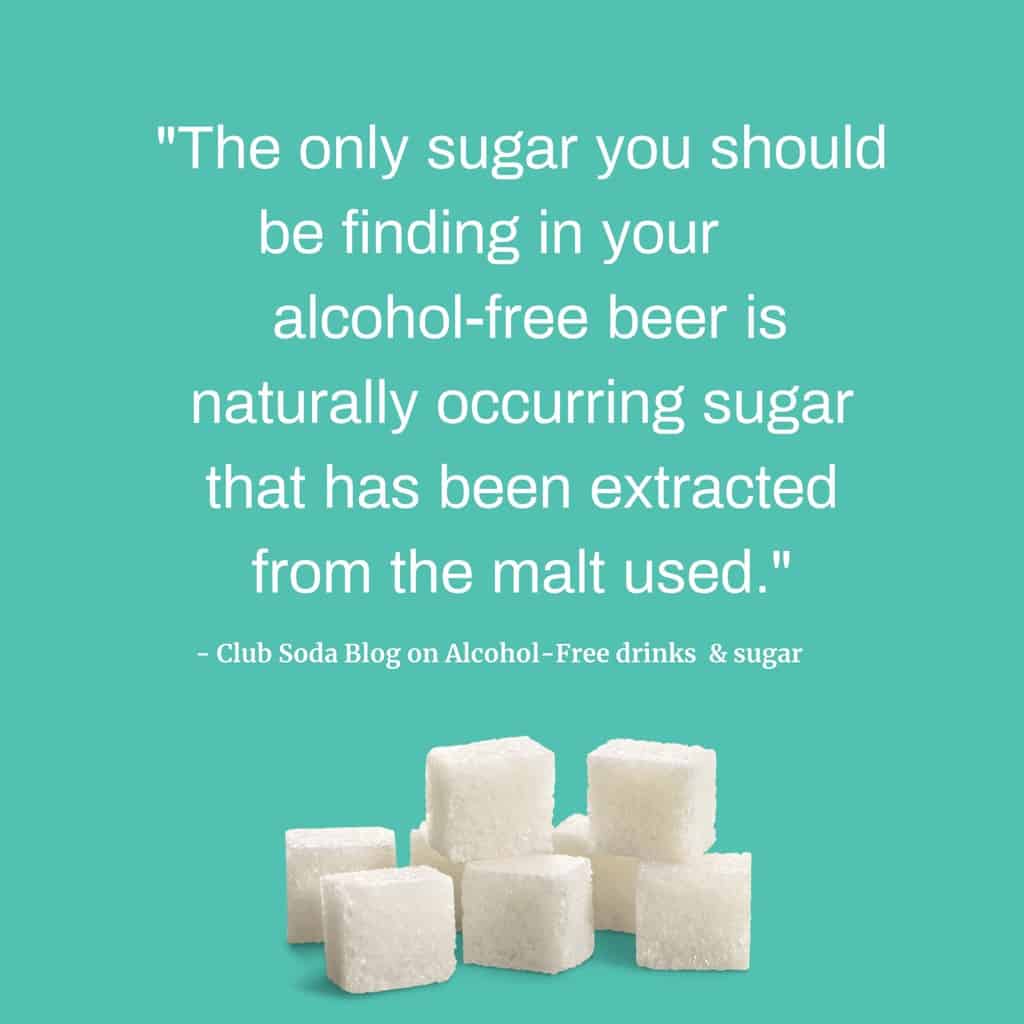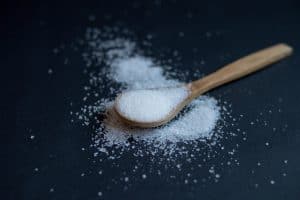
This website uses cookies to improve your experience. We'll assume you're ok with this, but you can opt-out if you wish. Read More
The Next Round: What happens after you change your drinking?

When many of us start to address our drinking behaviours, it is also part of a broader aim of improving our overall health. For many, weight and diet play a role in this desire for change. So it’s only natural that we begin to worry about the amount of sugar and calories in alcohol. Funny though, that we can happily share a bottle of wine in a restaurant, and then start to worry about sugar in alcohol-free drinks on the days that we choose not to drink.
When looking at alcohol-free alternatives, it’s important to think about the type of sugars we are consuming and make our decisions based on concrete information. We hope this blog will help you to do exactly that.
The effects of alcohol on our weight are two-fold, as it affects our ability to make healthful choices. Have you ever driven to work instead of walking because of a hangover? Alcohol also affects the way in which we choose our foods, and how our bodies burns calories.
We all know that once you’ve had a few drinks you are far less likely to prepare a nutritious meal. You will likely end up skipping dinner or reaching for fast and convenient foods. These are likely to be higher in saturated fats and more calorie-dense. This, combined with the calories we are drinking will easily push us over our recommended calorie intake for the day.
Your body burns off calories from alcohol before burning calories in food. Let’s say you drink 100ml of beer, and eat 100g of stew. Your body is going to attend to breaking down the calories from the alcohol before it turns its attention to dealing with the stew. If you’re drinking regularly, your body may not be effectively burning through food calories and will store these as fat.
The enzyme Aldh1a1 is responsible for converting alcohol to fat, and this fat builds up around your essential organs. This effect of this enzyme is suppressed by oestrogen. You may notice that men tend to gain a ‘beer belly’ at any age as their oestrogen levels are low, whereas women may feel that fat piles on faster around the waist as they go through menopause and oestrogen levels dip.

You may experience cravings for sweet things when you stop drinking alcohol. This is because alcohol gives you a dopamine hit and affects your brain chemistry. Sugar can have a similar effect on your energy, elevating your mood; think about the dreaded sugar high that kids get after too many sweets. When your brain is crying out for the buzz that alcohol gives you, the logical alternative may be to reach for something sweet instead.
Alcohol also has an effect on your blood sugar, your glucose level. It causes almost immediate spikes in your blood sugar, but also has a stimulating effect on the pancreas, causing it to secrete too much insulin. This can add up to weight gain, but most importantly it can cause hypoglycaemia – low blood sugar. That’s why you want a kebab when you head home, or a fizzy pop when you’re hungover. It takes time to rebalance your blood sugar levels.
You might find yourself eating more when you stop drinking. Alcohol can be satiating and filling, you may even have drunk when you were actually hungry. When you stop doing this, your body probably tells you it’s hungry more frequently.
Fructose is a naturally occurring sugar found in honey, vine fruits, berries, and most root vegetables. It is an important carbohydrate, your liver converts it into glucose so your body can use it as fuel. But fructose also exists commercially and is bonded with other types of sugars. It is added to products such as fruit juice, and foods that require browning. Fructose is also the sugar used to create high-fructose corn syrup. While in its natural form it can be a good sugar, too much of it can cause other issues.
Fructose is only partially absorbed in the small intestine, and will then travel to the large intestine. Here it will ferment. Long story short, this can lead to gastrointestinal symptoms such as bloating, gassiness, diarrhoea, and stomach pain.
There are five approved artificial sweeteners: saccharin, acesulfame, aspartame, neotame, and sucralose. It is believed that these sweeteners can actually alter the way in which you taste food. These sweeteners are potent, a small amount can be perceived as far sweeter than a larger amount of standard table sugar.
There are a couple of things to think about here. If for example you regularly consume diet soda which is full of artificial sweeteners, you may begin to perceive things like fruit that contain natural sugar as being less sweet. Foods that are not sweet at all, for example, certain vegetables may lose their appeal because your perception of sweetness is out of whack. This may lead you to seek out more processed foods because you are looking for an intensity of flavour that is familiar to you.
Consider also that artificial sweeteners may distort your perception of what is and isn’t healthy food. If you can drink something that tastes sweet yet has zero calories, you may lose your focus on what is and isn’t calorific and nutritionally sound. Some people will justify eating foods containing high levels of saturated fat by drinking zero-calorie drinks.
If calories, weight, or dieting are a concern for you, you might want to consider how diet and zero-calorie sodas will affect your long term goals for a healthier body. Are they a tool you can use effectively? Will they hinder you from getting to the bottom of your relationship with food, sugar, calories, and your body?
Whilst the sugar content of non-alcoholic drinks is usually as high or higher than their alcoholic counterparts, it does not mean you are always drinking more calories. Some soft drinks are lower in calorie count. With 7 calories per gram, the number of calories in alcohol is second only to fat which has 9 calories per gram.
For example, Bavaria alcohol-free wheat beer contains 3.6g of sugar. Hoegarden’s full-strength wheat beer contains just 0.1g of sugar. But the overall calorie content of Bavaria is only 27kcal, while Hoegarden’s is 58.6kcal. So you may want to think about where you are happiest to make your compromise. Are you wanting to reduce calories? Then maybe an alcohol-free beer is a better option, despite its sugar content.
Look for drinks that contain natural sugars. Kombucha is a great alternative to your big-brand sodas, as they are mostly made using cane sugar, and rarely contain added sugars and E numbers. Kombuchas that are flavoured with fruit are likely to contain more sugar, while those that focus only on the tea are likely to have lower sugar content.
Sparkling teas and other low-calorie sodas can also be a good option. Check the ingredients, a general rule of thumb is to look for very short lists of ingredients. If you see a collection of numbers and letters, it’s probably one to avoid. Most drinks will need to use some form of preservative, but in relation to sugar, the thing you want to look out for is E numbers. Large soft drinks brands will often use caramel colourings, which you will find on labels as E numbers. Look out for these on beer labels also, and avoid where possible.
The only sugar you should find in your alcohol-free beer is naturally occurring sugar that has been extracted from the malt used. You may occasionally find lactose, which is a milk sugar that helps to provide body and sweetness. Check the label for ‘malt syrup’ or ‘malt extract’, which is a concentrated form of the sugary liquid produced at the start of the brewing process, and may result in higher sugar content. The standard ingredients used in producing beer are malt, water, hops, and yeast, so check the label and read up on anything that seems unusual.
Alcohol-free ciders are usually slightly higher in sugar, and only slightly lower than their alcoholic equivalents in calories. You might want to intersperse these with soft drinks or add a little sparkling water to eek them out a little.
Alcohol-free wine is similar to beer in that it will usually be higher in sugar, but lower in calories than its full-strength counterpart. You will find that it will likely taste sweeter, and may not give you the same balance of flavour as full-strength wine. Alcohol also helps to provide the body in wine, so without it, the drink may seem thinner. Try looking for botanical blends as an alternative, which provides some of the nuances of flavour found in some more robust wines.
We write regular reviews of low and no alcohol drinks. And you can find hundreds of alcohol-free drinks on our online Guide, from beers, wines and spirits to soft drinks, kombuchas and tonics.
This website uses cookies to improve your experience. We'll assume you're ok with this, but you can opt-out if you wish. Read More
| Name | Domain | Purpose | Expiry | Type |
|---|---|---|---|---|
| wpl_user_preference | joinclubsoda.com | WP GDPR Cookie Consent Preferences. | 1 year | HTTP |
| PHPSESSID | www.tickettailor.com | PHP generic session cookie. | 55 years | HTTP |
| AWSALB | www.tickettailor.com | Amazon Web Services Load Balancer cookie. | 7 days | HTTP |
| YSC | youtube.com | YouTube session cookie. | 55 years | HTTP |
| Name | Domain | Purpose | Expiry | Type |
|---|---|---|---|---|
| VISITOR_INFO1_LIVE | youtube.com | YouTube cookie. | 6 months | HTTP |
| Name | Domain | Purpose | Expiry | Type |
|---|---|---|---|---|
| _ga | joinclubsoda.com | Google Universal Analytics long-time unique user tracking identifier. | 2 years | HTTP |
| sbjs_migrations | joinclubsoda.com | Sourcebuster tracking cookie | 55 years | HTTP |
| sbjs_current_add | joinclubsoda.com | Sourcebuster tracking cookie | 55 years | HTTP |
| sbjs_first_add | joinclubsoda.com | Sourcebuster tracking cookie | 55 years | HTTP |
| sbjs_current | joinclubsoda.com | Sourcebuster tracking cookie | 55 years | HTTP |
| sbjs_first | joinclubsoda.com | Sourcebuster tracking cookie | 55 years | HTTP |
| sbjs_udata | joinclubsoda.com | Sourcebuster tracking cookie | 55 years | HTTP |
| sbjs_session | joinclubsoda.com | SourceBuster Tracking session | Session | HTTP |
| Name | Domain | Purpose | Expiry | Type |
|---|---|---|---|---|
| mailchimp_landing_site | joinclubsoda.com | Mailchimp functional cookie | 28 days | HTTP |
| __cf_bm | tickettailor.com | Generic CloudFlare functional cookie. | Session | HTTP |
| NID | google.com | Google unique id for preferences. | 6 months | HTTP |
| Name | Domain | Purpose | Expiry | Type |
|---|---|---|---|---|
| _ga_10XZMT03ZM | joinclubsoda.com | --- | 2 years | --- |
| AWSALBCORS | www.tickettailor.com | --- | 7 days | --- |
| cf_clearance | tickettailor.com | --- | 1 year | --- |
| VISITOR_PRIVACY_METADATA | youtube.com | --- | 6 months | --- |
Join Club Soda for 10% off your first order of drinks for UK delivery. Plus get our latest news and special offers for members to choose better drinks, change your drinking and connect with others.
If you get an error message with this form, you can also sign up at eepurl.com/dl5hPn